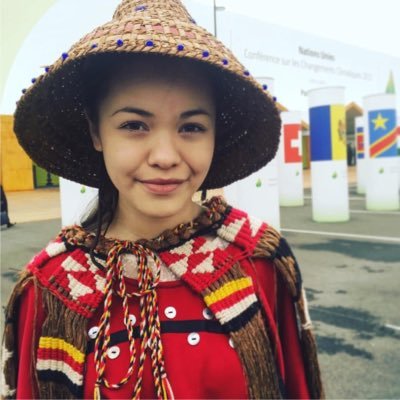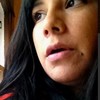Bridget Tolley, lives on the Kitigan Zibi Anishinabeg First Nation in Quebec. An Algonquin community of over 1,500 people located east of Ottawa, the community has three public water systems which Health Canada says have all been under drinking water advisories since 1999. Tolley’s house draws water from a private well but it too is unsafe to drink. “We still get bottled water, that’s four bottles a week. If you run out you have to buy your own.When we take showers, we use the water because we have no choice. Unless I boil water for every little thing that we do. But there’s so many of us in the house with the grandchildren, too.So we use the water. I am worried, I’ve always been worried about the kids getting something, or even myself.Sometimes I just happen to drink it, I pour a glass, not thinking.We take showers too, we brush our teeth, there are so many things that we do with that water, how can we not when we get only four bottles per house, not per family.I wish people understood what it means to have clean water, to be able to drink and to live.We get a lot of cancers. One of these days the water is going to kill us if we don’t take care of it.”
“We still get bottled water, that’s four bottles a week. If you run out you have to buy your own.When we take showers, we use the water because we have no choice. Unless I boil water for every little thing that we do. But there’s so many of us in the house with the grandchildren, too.So we use the water. I am worried, I’ve always been worried about the kids getting something, or even myself.Sometimes I just happen to drink it, I pour a glass, not thinking.We take showers too, we brush our teeth, there are so many things that we do with that water, how can we not when we get only four bottles per house, not per family.I wish people understood what it means to have clean water, to be able to drink and to live.We get a lot of cancers. One of these days the water is going to kill us if we don’t take care of it.” “I was born in 1991 and as far as I know I could never drink from the tap while living on this reserve. I’m 26 years old now and I still get my water from the reverse osmosis machine from the plant. Actually I don’t remember drinking from a tap, it was always water jugs.I guess the First Nation and the federal government agreed on upgrading the water facility in the community because of the boil water advisory.Some people get rashes and whatnot, hopefully that changes with the project that’s suppose to happen this summer.I actually just use tap water to bathe my daughter because she’s getting bigger and it’s a hassle boiling water. But I notice right now she’s developing some kind of rash.Canada is supposed to be the richest country in the world…and First Nations people are still living in a third world society.”
“I was born in 1991 and as far as I know I could never drink from the tap while living on this reserve. I’m 26 years old now and I still get my water from the reverse osmosis machine from the plant. Actually I don’t remember drinking from a tap, it was always water jugs.I guess the First Nation and the federal government agreed on upgrading the water facility in the community because of the boil water advisory.Some people get rashes and whatnot, hopefully that changes with the project that’s suppose to happen this summer.I actually just use tap water to bathe my daughter because she’s getting bigger and it’s a hassle boiling water. But I notice right now she’s developing some kind of rash.Canada is supposed to be the richest country in the world…and First Nations people are still living in a third world society.” “It makes me feel sad that my loved ones, elders and little cousins and nieces and nephews, that they have to be exposed to that risk. And also, I feel very disappointed and powerless when it comes to the pollution of our water bodies and oceans because there is not a lot of immediate work that can be done to effectively shut down industry in that area and clean up the pollution in the water. And as a result we just have to continue to watch the deterioration of our sacred sites and land. And it leads to a restricted amount of options for cultural revival programs and practices and different ways we can bring the traditions back.”“The amount of Indigenous communities that don’t have access to clean drinking water is so alarmingly high [in Canada], for a nation that’s known for its progressiveness and care of its citizens.“The intergenerational trauma from different colonial institutions such as residential schools, and the Sixties Scoop and the repression that our people have experienced, it’s internalized as pain and it creates a really toxic dynamic of how we relate to each other. There are really important conversations reconciling this pain between each other, but those conversations can’t be held until we are at a space where we are secure, where we’re not on an immediate, day to day basis, questioning if our water is good enough to drink and if we’ll have enough food to feed the family.”
“It makes me feel sad that my loved ones, elders and little cousins and nieces and nephews, that they have to be exposed to that risk. And also, I feel very disappointed and powerless when it comes to the pollution of our water bodies and oceans because there is not a lot of immediate work that can be done to effectively shut down industry in that area and clean up the pollution in the water. And as a result we just have to continue to watch the deterioration of our sacred sites and land. And it leads to a restricted amount of options for cultural revival programs and practices and different ways we can bring the traditions back.”“The amount of Indigenous communities that don’t have access to clean drinking water is so alarmingly high [in Canada], for a nation that’s known for its progressiveness and care of its citizens.“The intergenerational trauma from different colonial institutions such as residential schools, and the Sixties Scoop and the repression that our people have experienced, it’s internalized as pain and it creates a really toxic dynamic of how we relate to each other. There are really important conversations reconciling this pain between each other, but those conversations can’t be held until we are at a space where we are secure, where we’re not on an immediate, day to day basis, questioning if our water is good enough to drink and if we’ll have enough food to feed the family.”

Advertisement
Marcus Monias, 26, is a father of two who lives on the Neskantaga First Nation in northern Ontario, a community of 340 that according to Health Canada has been under a boil-water advisory since 1995 – the longest in Canadian history. In 2017, the federal government announced it would spend $8.8 million on a new water treatment plant aimed at ending the boil-water advisory for good.

Advertisement
Sixteen year old Ta’kaiya Blaney, a member of Tla A’min Nation, has traveled the world, singing and orating about Indigenous rights.She grew up primarily off reserve, along the Salish Sea in British Columbia, but the water crisis has hit close to home. Although her First Nation is not officially on a boil water advisory, she says her grandfather has to put rubbing alcohol in his bath to disinfect the water, and other people in her community suffer through skin irritations and other issues when they bathe. In addition to that, pollution in the ocean surrounding her village makes it difficult for her people to practice their cultural ways of sustenance and gathering of shellfish.

VICE News Canada is spending this week focusing on the Indigenous water crisis. Read more here.
